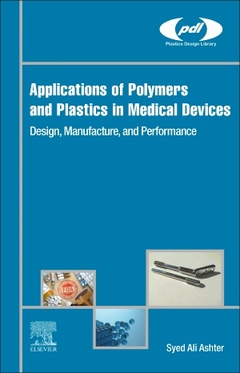Applications of Polymers and Plastics in Medical Devices Design, Manufacture, and Performance Plastics Design Library Series
Auteur : Ashter Syed Ali

Applications of Polymers and Plastics in Medical Devices: Design, Manufacture, and Performance is a comprehensive guide to plastic materials for medical devices, covering fundamentals, materials, applications and regulatory requirements. Sections cover the role of plastics in medical devices, socioeconomic factors, the classification of medical devices. The performance of, medical grades and suppliers of polymer materials, which are categorized by performance level are also explored, along with manufacturing processes for device components, including extrusion, casting, injection molding and assembly processes. The book then covers applications in detail, examining each device and the role that polymers and plastics play in its construction and function.
This is an essential resource for engineers, R&D, and other professionals working on plastics for medical devices and those in the plastics industry, medical device manufacturing, pharmaceuticals, packaging and biotechnology. In an academic setting, this book is of interest to researchers and advanced students in medical plastics, plastics engineering, polymer science, mechanical engineering, chemical engineering, biomedical engineering and materials science.
1. Introduction to polymers and plastics for medical devices 2. Classification of medical devices 3. Selection of materials for construction of medical devices 4. Classifications of plastics and elastomers used in medical devices 5. Low performance demand plastics and elastomers for medical devices 6. Medium performance demand plastics and elastomers for medical devices 7. High performance demand plastics and elastomers for medical devices 8. Plastics Fabrication Techniques 9. Manufacturing of plastics medical device components 10. Therapeutic applications of medical devices 11. Applications of biobased polymers in medical devices 12. Regulatory requirements for medical devices 13. Market Trends and Global Sourcing of Medical Devices 14. Reprocessing of reusable medical devices 15. Economics and future direction of Medical Devices
- Offers systematic coverage of the major classes of polymers used in medical devices, including properties, characteristics, performance, medical grades and suppliers
- Reviews regulatory requirements of the FDA and other global agencies, as well as considering quality control and socioeconomic factors
- Includes the latest advances in plastics for medical devices, such as novel applications, use of bio-based polymers, and processing of reusable medical devices
Date de parution : 03-2022
Ouvrage de 304 p.
15.2x22.8 cm
Thèmes d’Applications of Polymers and Plastics in Medical Devices :
Mots-clés :
510(k)CDSCO; Acetal copolymer; Acrylonitrile butadiene styrene; Arkema; Autoclave; Automated external defibrillators; Balloon; Basic definitions; Biocompatibility; Biocomposite; Bioscaffolds; Biosurgery; Bonding; Cardiac ablation catheter; Cardiovascular and heart rhythm; Catheter; Ceramics; Cleaning validation; CNC; Cost of care; Design control; Design validation; Design verification; Dimensional stability; Direct cost; Distal; EDM; Elastomers; EMA; Ethylene oxide; Extractables; Extrusion; FDA; Gamma radiation; Glass; Good quality; Hemostats; IDE; IMDRF; Implant; In vitro diagnostics; Indirect cost; Indirect quality cost; Injection molding; Interventional cardiology; ISO 13485Medical device; Leachables; LIM; Lubrication; Manifold bonding; Market drivers; Market restraints; Market trends; MDR; Medical device; Medical devices; Milling; NMPA; Panther fusion system; PEEK; PHA; Plastics; PLC; Polybutylene terephthalate; Polycarbonate; Polydimethylsiloxane; Polyetheretherketone; Polyetherimide; Polyethylene; Polymethylmethacrylate; Polyphenyl sulfone; Polyphenylene oxide; Polyphenylene sulfide; Polypropylene; Polystyrene; Polysulfone; Polyvinyl chloride; Polyvinylidene fluoride; Poor quality; Postmarket surveillance; PPSU; Premarket approval; Process validation; Procurement; Prosthetics implants; Proximal fuse; Proximal; PSU; Quality assurance; Radiopacity; Reprocessing; RESOMER; Reusable; RO Marker; Silicone molding; Skiving; Socioeconomic factors; Solvay; Staking; Steam sterilization; Sterilization; Suture anchors; Thermoplastic elastomer; Thermoplastic polyurethane; Thermosets; Thoracic drainage systems; Toxicological risk assessment; Tubing; Turning; Two-part molding; User interface; Vascular grafts; Vascular patches; Vascular surgery; VISTAKEEP; Water jet cutting



